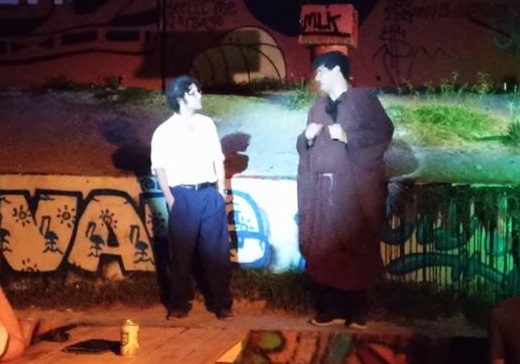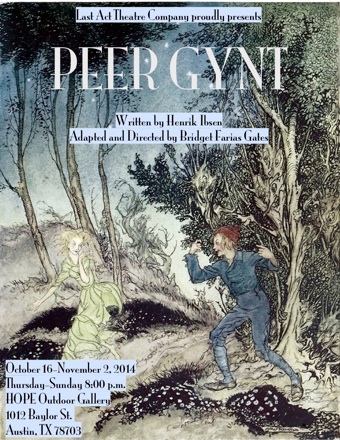Review: Peer Gynt by Last Act Theatre Company
by Michael Meigs
Henrik Ibsen's second-floor apartment is maintained and curated today as a major tourist attraction in Oslo, the capital of Norway. This past summer we found it rather impressive; it's so centrally located that in the last years of his life the grumpy little man with sideburns and top hat could easily take his daily constitutional down to the Grand Cafe for cigars and coffee. By that time he was a Great Man, eagerly pointed out by the locals to the tourists and caricatured in leading magazines across Europe and North America.
Ibsen was pretty much washed up by then, riding his reputation as one of the most important creators of European realistic drama. He'd risen from modest circumstances. He'd been pretty much a failure right into his mid-30's, working at the city theatres in Bergen and later in the capital Christiana (now Oslo). In 1864 he took his wife and child to Italy and stayed away for 27 years. All of his most noted plays were written in self-exile and published in Denmark. The verse tragedy Brand (1865) brought him some renown and a measure of financial security. Peer Gynt (1867) followed, also in verse. This experimental work told the vast frolicking story of a young rascal with a wild imagination who left Norway for the greater world, finding adventure while winning and losing fortunes along the way, unable to find himself or his true love until his return to Norway as a lonely old man.
Peer Gynt is a vast sprawling narrative that mixes real and surreal, including scenes of village life, encounters with trolls, Peer's adventures in Egypt and as a slave trader, his life with a harem, encounters in a madhouse and more. Ibsen, familiar with the possibilities of the contemporary theatre, doubted that it could ever be produced onstage, but in less than a decade the Christiana Theatre triumph in 1876 proved him wrong.
Director Bridget Farias took on an enormous challenge in this production for Last Act Theatre Company (LATCO). She cut and consolidated the piece, working from three translations, reducing it from roughly five hours of stage time to three; when an annoyed resident near the venue wanted to complain to the City about late-night noise, she eliminated another half an hour and moved the start time up to 7 p.m. LATCO, a company of ingenuity, has successfully located non-conventional performing venues all over town, and the Hope Outdoor Gallery is certainly one. It's a collection of half-built structures covered with grafitti, on the hillside just west of Lamar at 11th street. Unexpected changes at the site made impossible Farias's plans to move the audience from place to place with the action, so blocking had to be changed almost at the last minute. And while we're at it: lighting is primitive, run by a generator ineffectually shielded for noise, there's no amplification, and unassociated loiterers with flashlights wander around, about and above the playing space. You have to love LATCO and love the theatre experience to get past so many evident obstacles.

This extraordinary text and LATCO's Peer Gynt, Andrew Bosworth, are enough to make you forget those disadvantages. Though the script seems far from the rigorously rhymed verse of the Norwegian original, it retains the images, the lift and the playfulness of fable. Bosworth's line load is staggering, for he's central to almost every scene. He's sure footed both on the terrain and through the text. Peer's a trickster, a liar and a rapscallion, successfully seducing both a village bride and the daughter of the Troll King and getting away with both indiscretions. Bosworth has witty delivery, the grace of a vaudeville song-and-dance man, and an evident deep understanding throughout of where he's going with this character. It's a cautionary tale, a decades-long walk on the wild side that makes our protagonist not much wiser about the meaning of existence. By the time Peer's back in his home village facing Death in the figure of the great tinsmith who melts down all souls, Bosworth is moving his character with the restrictions of age, working his mouth and his wit desperately to find a compromise.

Fritz Ketchum appears early and late in the action as Peer's mother Åse, scandalized but entranced by her naughty boy. As she's dying, Peer takes her on a pretended wagon ride to heaven, perhaps the first time that he's faced the prospect of his own demise. Taylor Flanagan is the eternally sweet, patient and neglected Solveig, Peer's eventual safe harbor, too late to suggest any salvation but a peaceful end. The other eleven members of the ensemble flicker in and out of the action and the lights, filling in Ibsen's well-populated imaginary universe.
Peer Gynt  has autobiographical traces beyond Ibsen's self-exile and return. Both Ibsen and Peer were from families ruined by a father's financial incompetence; Peer's incautious seduction of the Troll King's snouted daughter could be seen as a not very gentlemanly recycling of the teenage Ibsen's knocking up a servant girl. But the man-boy's willful imagination and desire to seek a wider world are universal, as is his refusal to accept responsibility; in a lighter, Disneyfied version Peer would be Peter Pan without a Neverland, neglectful of his Wendy.
has autobiographical traces beyond Ibsen's self-exile and return. Both Ibsen and Peer were from families ruined by a father's financial incompetence; Peer's incautious seduction of the Troll King's snouted daughter could be seen as a not very gentlemanly recycling of the teenage Ibsen's knocking up a servant girl. But the man-boy's willful imagination and desire to seek a wider world are universal, as is his refusal to accept responsibility; in a lighter, Disneyfied version Peer would be Peter Pan without a Neverland, neglectful of his Wendy.
Ibsen abandoned verse after writing Peer Gynt and turned for a time to historical prose theatre. He then devoted himself to realistic dramas of ideas and made his enduring reputation. Almost all of his significant works were written abroad. He returned to the Norwegian capital in 1891, shortly after completing Hedda Gabler, and lived there until his death in 1906.
Ibsen probably wasn't prescient when deciding that Peer the prodigal would return home to face death. After all, a life-cycle play has one inevitable end, and Peer Gynt was crafted with Norwegian folk traditions very much in mind.
Though Norway claims him and his statue stands resolutely before the National Theatre, the universal themes of Ibsen's greatest works, including Peer Gynt, resound across Western culture. LATCO's version of the play confirms that. It's a reward to the audience, delivered by a young, capable and devoted cast and crew.
Peer Gynt
by Henrik Ibsen
Last Act Theater Company
Dates: October 16-November 2, 2014
Times: Thursday-Sunday at 7:00 p.m.
Price: $15.00
